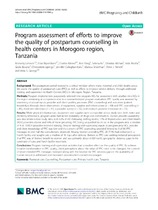| dc.contributor.author | LeFevre, Amnesty | |
| dc.contributor.author | Mpembeni, Rose | |
| dc.contributor.author | Kilewo, Charles | |
| dc.contributor.author | George, Asha S. | |
| dc.date.accessioned | 2018-07-09T07:19:51Z | |
| dc.date.available | 2018-07-09T07:19:51Z | |
| dc.date.issued | 2018 | |
| dc.identifier.citation | LeFevre, A. et al. (2018). Program assessment of efforts to improve the quality of postpartum counselling in health centers in Morogoro region, Tanzania. BMC Pregnancy and Childbirth, 18: 282 | en_US |
| dc.identifier.issn | 1471-2393 | |
| dc.identifier.uri | https://doi.org/10.1186/s12884-018-1906-y | |
| dc.identifier.uri | http://hdl.handle.net/10566/3863 | |
| dc.description.abstract | BACKGROUND: The postpartum period represents a critical window where many maternal and child deaths occur.
We assess the quality of postpartum care (PPC) as well as efforts to improve service delivery through additional
training and supervision in Health Centers (HCs) in Morogoro Region, Tanzania.
METHODS: Program implementers purposively selected nine program HCs for assessment with another nine HCs in
the region remaining as comparison sites in a non-randomized program evaluation. PPC quality was assessed by
examining structural inputs; provider and client profiles; processes (PNC counselling) and outcomes (patient
knowledge) through direct observations of equipment, supplies and infrastructure (n = 18) and PPC counselling (n
= 45); client exit interviews (n = 41); a provider survey (n = 62); and in-depth provider interviews (n = 10).
RESULTS: While physical infrastructure, equipment and supplies were comparable across study sites (with water and
electricity limitations), program areas had better availability of drugs and commodities. Overall, provider availability
was also similar across study sites, with 63% of HCs following staffing norms, 17% of Reproductive and Child Health
(RCH) providers absent and 14% of those providing PPC being unqualified to do so. In the program area, a median
of 4 of 10 RCH providers received training. Despite training and supervisory inputs to program area HCs, provider
and client knowledge of PPC was low and the content of PPC counseling provided limited to 3 of 80 PPC
messages in over half the consultations observed. Among women attending PPC, 29 (71%) had delivered in a
health facility and sought care a median of 13 days after delivery. Barriers to PPC care seeking included perceptions
that PPC was of limited benefit to women and was primarily about child health, geographic distance, gaps in the
continuity of care, and harsh facility treatment.
CONCLUSIONS: Program training and supervision activities had a modest effect on the quality of PPC. To achieve
broader transformation in PPC quality, client perceptions about the value of PPC need to be changed; the content
of recommended PPC messages reviewed along with the location for PPC services; gaps in the availability of
human resources addressed; and increased provider-client contact encouraged. | en_US |
| dc.language.iso | en | en_US |
| dc.publisher | BioMed Central | en_US |
| dc.rights | © The Author(s). 2018 Open Access This article is distributed under the terms of the Creative Commons Attribution 4.0
International License (http://creativecommons.org/licenses/by/4.0/), which permits unrestricted use, distribution, and
reproduction in any medium, provided you give appropriate credit to the original author(s) and the source, provide a link to
the Creative Commons license, and indicate if changes were made. The Creative Commons Public Domain Dedication waiver
(http://creativecommons.org/publicdomain/zero/1.0/) applies to the data made available in this article, unless otherwise stated | |
| dc.subject | Postnatal care | en_US |
| dc.subject | Counselling | en_US |
| dc.subject | Postpartum care | en_US |
| dc.subject | Primary health care | en_US |
| dc.subject | Tanzania | en_US |
| dc.title | Program assessment of efforts to improve the quality of postpartum counselling in health centers in Morogoro region, Tanzania | en_US |
| dc.type | Article | en_US |
| dc.privacy.showsubmitter | FALSE | |
| dc.status.ispeerreviewed | TRUE | |

